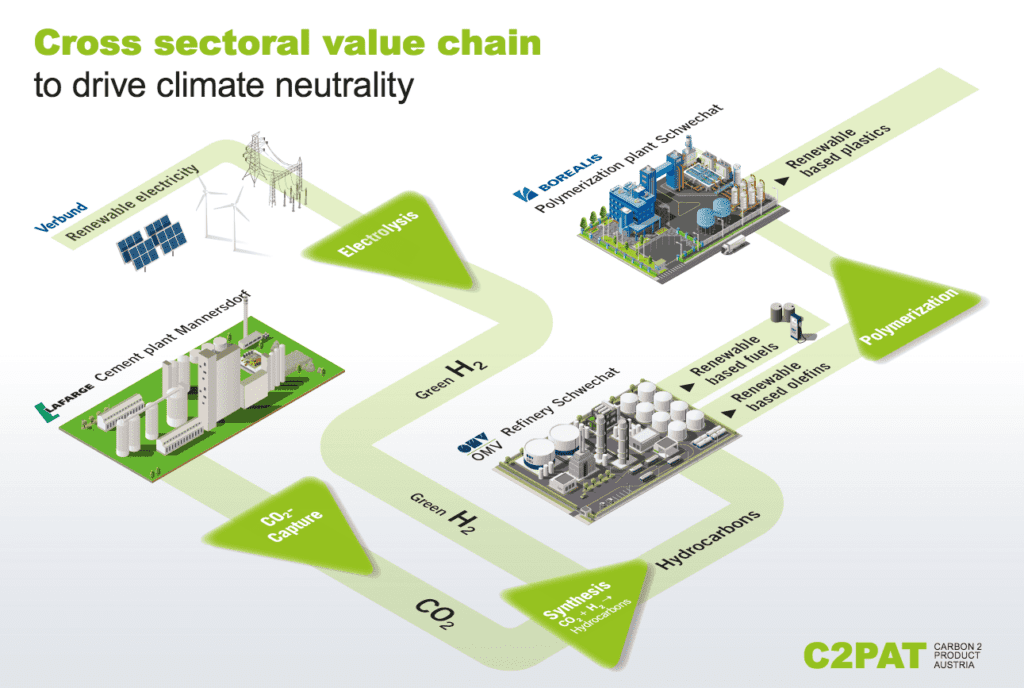In Austria, a consortium of Lafarge Zementwerke, a member of LafargeHolcim Group, OMV, VERBUND and Borealis have co-signed a Memorandum of Understanding (MOU) for the joint planning and construction of a full-scale plant by 2030 to capture CO2 and process it into synthetic fuels, plastics or other chemicals. Climate neutrality, circularity and innovation in Austria are driven by establishing a cross sectoral value chain for carbon capture. This innovative project significantly reduces emissions from cement production, establishing the green-house gas CO2 as a valuable raw material.
In the MOU, partners have agreed on collaborating across industry sectors in the project, entitled ‘Carbon2ProductAustria’ (C2PAT). Its objective is to create a cross-sectorial value chain and to operate a full-scale plant by 2030 which will eventually capture almost 100% of the annually emitted 700,000 tons of CO2 at Lafarge’s cement plant in Mannersdorf, Austria. The aim is to ultimately use the captured CO2 as a resource.

Source: OMV
In combination with green hydrogen (produced with renewable energies) produced by VERBUND, the captured CO2 will be transformed by OMV to renewable based hydrocarbons, which, in turn can be used to produce renewable based fuels or be utilized by Borealis as a feedstock to manufacture value-add plastics.
“We are committed to leading the industry in reducing carbon emissions and shifting towards low-carbon construction. We have worked consistently and successfully on the reduction of the CO2 footprint of our cement plants, products and solutions. Ultimately, CO2-neutral cement production can only be possible with the implementation of breakthrough technologies, like Carbon Capture, which is why we have great expectations for the C2PAT project”, Lafarge CEO José Antonio Primo points out.
Given that C2PAT is implemented, the 700,000 tons of CO2 per year can be transformed into synthetic fuel by OMV. Further, the partners aim to investigate a truly circular approach: with Borealis being a key partner, the captured CO2 can be used for the production of renewable based, value-add plastics. These plastics are especially suited for recycling at the end of their lifetime, and with this, enable a nearly closed CO2 loop.
VERBUND, Austria’s largest electricity company, will supply the green hydrogen used to recy-cle the captured CO2: “Green hydrogen is produced when water is electrolyzed using electricity from renewable sources. For the Carbon2ProductAustria-Project we will use green electricity from our renewable generation portfolio,” explains Michael Strugl, Deputy CEO VERBUND. “Green hydrogen offers huge potential for decarbonizing CO2-intensive industrial processes. In order to reach our national and global climate goals we have to collaborate across sectors and join our efforts for decarbonization and climate neutrality.”
The success of C2PAT will largely depend on whether the right financial and regulatory framework conditions are created both at the EU and Austrian national level. With this ambitious collaboration, Lafarge, OMV, VERBUND and Borealis are showcasing an innovative and viable solution for the transformation towards a Zero CO2 economy in Europe.
Rainer Seele, OMV Chairman of the Executive Board and CEO: “Climate protection requires innovation and cooperation. With this project we aim to do both, and it shows that economic viability and climate protection go hand in hand based on new technologies. CO2 is not just a greenhouse gas that we have to reduce. It is also a valuable raw material from which we can produce synthetic fuels and feedstock for the chemical industry.”
“Circularity requires us to consider the whole system, and not default to the least change, line-ar option because it is more convenient,” comments Borealis CEO Alfred Stern. “The plastics industry can be a powerful contributor to climate action, through materials replacement that reduces weight, by minimizing food waste and by shifting to well-designed circularity that reduces CO2 emissions. We are excited to join forces with our industry partners on our mission to drive the change towards a Zero CO2 industry.”
The main objective of C2PAT is to engineer and operate a carbon capture plant at the cement plant in Mannersdorf, Austria as well as to build an infrastructure and a fully operating system for producing renewable based hydrocarbons and using this compound to produce a broad range of renewable based olefins, plastics and fuels. The partners aim to put the full- scale plant into operation by 2030. A first step towards this goal will be to further investigate current technological and economic hurdles by jointly conducting research and development activities regarding the envisaged Carbon Value Chain.
The joint project is designed in 3 phases: In phase 1, the partners are currently evaluating and developing a joint strategy for project development, business modelling and process engineer-ing. Based on the results of phase 1, a cluster of industrial pilot plants in the Eastern part of Austria could be technically developed and realized until 2023 in phase 2. Phase 3 entails the full realization of the presented vision by scaling up to the full size of 700,000 tons of CO2 to be captured and used and will demonstrate the global scalability of the project.